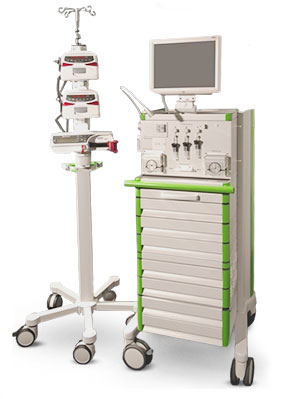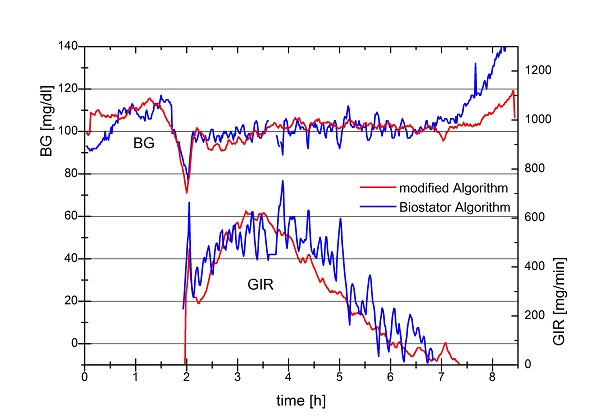Glucose Clamps
The pharmacokinetic/pharmacodynamic (PK/PD) effects of anti-diabetic drugs are usually characterized in glucose clamp experiments where variable glucose infusion rates (GIR) keep blood glucose concentrations (BG) as closely as possible to a pre-defined target level. The metabolic effect of the investigated anti-diabetic drug is then characterized by the time course of the GIR. For a high glucose clamp quality low BG- und GIR-variability are desirable. In automated glucose clamps the GIR is usually calculated every minute by an implemented algorithm such as the Biostator algorithm published in 1982. This algorithm is crucial for good clamp quality and an improved algorithms leads directly to improved clamp quality.
For ClampArt, our CE-marked state-of-the-art glucose clamp device, we optimized the implemented algorithm to reduce the oscillations of both BG and GIR.

1st step to improve the Clamp Algorithm: in-silico
For the first optimisation step we developed a numerical simulator for glucose clamps. In glucose clamps usually an i.v. glucose sensing as well as an i.v. glucose infusion is used. Because the glucose sensing and the infusion are using the same compartment, a single compartment model was selected for the simulator. With this simulator we optimized the algorithm with respect to the oscillations of BG and GIR.
This in-silico optimization of the algorithm showed a reduction in the amplitudes of the oscillations in BG to 43% and GIR to 66% of those observed with the Biostator algorithm.
2nd step to improve the Clamp Algorithm: in-vitro
On the basis of the results from the numerical simulations we started in-vitro experiments to confirm the optimization with the ClampArt device.
Both the Biostator algorithm as well as the optimized algorithm was integrated into the ClampArt device and used to calculate and administer the appropriate amount of 20% glucose solution to keep the glucose concentration within the container at target level.
These in-vitro experiments showed similar results as the simulator with a reduction of oscillations of both BG (61%) and GIR (76%).
3rd step to improve the Clamp Algorithm: in-vivo
On the basis of the successful computer simulations and the corresponding successful tests with a dummy-clamp we performed a small number of in-vivo clamps with real subjects using ClampArt with the optimized algorithm. Our aim was to evaluate the difference between the Biostator algorithm and the optimized algorithm with respect to the oscillation of both BG and GIR in patients with type 1 diabetes.
The results of the simulations and the in-vitro testing were confirmed with the in-vivo clamps: We observed reduced amplitudes of oscillations for BG (35%) as well as for GIR (65%).

Results:
- We first improved the Biostator algorithm by in-silico numerical simulation of glucose clamps.
- With the results of the simulation we started in-vitro experiments to confirm the results obtained by the optimized algorithm.
- Finally we performed a small number of in-vivo clamps in T1DM patients using the optimized algorithm.
- The optimized algorithm reduced the amplitude of oscillations of both BG and GIR in all three settings.
Conclusions:
- ClampArt is a modern and safe device with tight BG control in fully automated glucose clamp studies.
- We developed an optimized algorithm that lowered the amplitude of oscillations of both BG (by 35%-61%) and GIR (by 65%-76%) without compromising or even slightly improving clamp quality.
- This optimized algorithm has now been implemented in ClampArt and will be used for future glucose clamp studies.
- Further improvements of the ClampArt algorithm, especially with varying target levels (i.e., step-wise changes in BG target), are currently tested in-vitro.
Read more about glucose clamping on our other blog posts (quality control, published review on clamping) , our page on hyperinsulinemic euglycemic clamp, or our free online seminar on glucose clamping.




